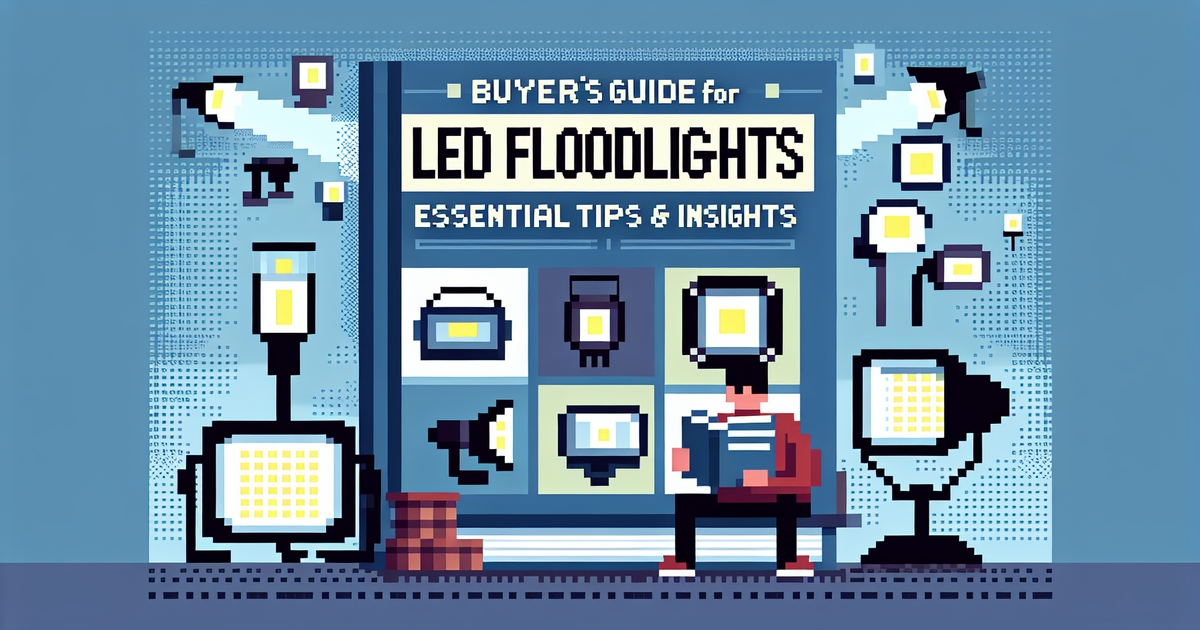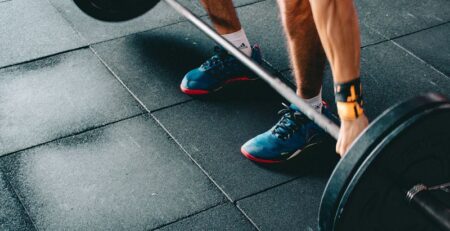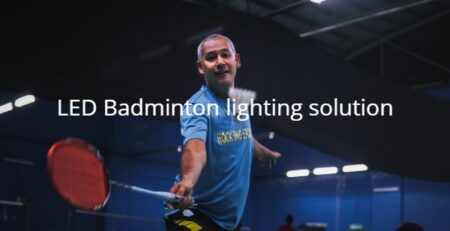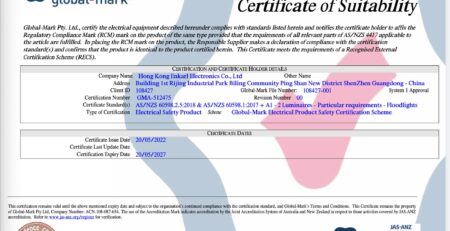Buyer’s Guide for LED Floodlights [2024]: Essential Tips & Insights
![Buyer's Guide for LED Floodlights [2024]: Essential Tips & Insights 1 Buyer's Guide for LED Floodlights: Essential Tips & Insights](https://www.enkarl.com/wp-content/uploads/2024/10/txt2img_SGXGg3QoFv_de_buyers-guide-for-led-floodlights-ess-1.jpg)
Did you know that LED floodlight fixtures can save up to 80% on energy costs in a way that traditional bulbs do not, side by side, when measured in watts? This makes them a smart choice for anyone wanting to light up their space efficiently with outdoor flood lights, wattage lights, outdoor floodlights, and LED floodlights. A buyer’s guide for LED floodlights helps you navigate the watt options available in the market.
From brightness levels to energy ratings, including watt and LED flood lights, understanding these factors is key. Whether you need LED flood lights for your backyard, garage, or commercial area, knowing the watt and what to look for ensures you make the right purchase. This guide will break down essential features and tips. You’ll gain confidence in choosing the best LED floodlight that fits your needs and budget.
Key Takeaways
- Know Your Needs: Before buying, assess where and how you plan to use LED floodlights to ensure you choose the right type for your space.
- Check Specifications: Pay attention to key specifications like brightness (measured in lumens), energy efficiency (wattage), and color temperature of LED flood lights to match your requirements.
- Follow Installation Guidelines for LED flood lights: Proper installation is crucial for safety and performance. Follow the manufacturer’s instructions for the LED flood lights carefully or consult a professional if needed.
- Consider Long-Term Costs: While LED floodlights may have a higher upfront cost, they save money over time through lower energy bills and longer lifespans.
- Explore Versatile Uses: LED floodlights can be used for various applications, from outdoor security lighting to illuminating sports fields, making them a versatile choice.
- Stay Informed on Trends: Keep up with new technologies and features in LED floodlights to ensure you are making the best investment for your needs.
![Buyer's Guide for LED Floodlights [2024]: Essential Tips & Insights 2 Understanding LED Floodlights](https://www.enkarl.com/wp-content/uploads/2024/10/txt2img_JRDC01xGUp_de_understanding-led-floodlights-1.jpg)
Understanding LED Floodlights
Overview and Features
LED floodlights are versatile lighting solutions. They work well for both indoor and outdoor applications. You can use them for security, flood lights, landscape lighting, or even sports fields. These lights are known for their energy efficiency. They consume less power than traditional lights. This feature helps save on electricity bills.
A long lifespan is another key benefit of LED flood lights. Many last over 25,000 hours. This means fewer replacements and lower maintenance costs. These lights come in various wattages and color temperatures. Common options include 15 watts to over 400 watts. Color temperatures typically range from warm white to cool daylight, including flood lights.
Types and Variations
Different types of mounts exist for LED floodlights. Knuckle mount fixtures allow for flexible positioning. Slip fitter mounts attach directly to poles or brackets. Yoke mount designs provide stability and adjustability.
Wattage varies widely among LED flood light fixtures. Some small models use only 15 watts, while larger commercial LED flood lights can exceed 400 watts. Color temperature options also differ. Most users prefer 4000K or 5000K flood lights, which offer bright, clear light.
Benefits of Choosing LED
Choosing LED floodlights offers many advantages. They significantly reduce energy consumption compared to traditional lighting. This reduction leads to lower electricity bills over time.
Longer operational life is another major benefit. Traditional bulbs and flood lights may need frequent replacements, but LEDs last much longer. Lower maintenance costs follow from this durability as well.
Environmental benefits are crucial too. Using LED flood lights helps decrease the carbon footprint. Less energy use, such as using LED flood lights, means fewer greenhouse gas emissions from power plants, including those from flood lights.
![Buyer's Guide for LED Floodlights [2024]: Essential Tips & Insights 3 LED Floodlights Key Specifications to Consider](https://www.enkarl.com/wp-content/uploads/2024/10/txt2img_Jb7lXJz0O__de_led-floodlights-key-specifications-t-1.jpg)
Key Specifications to Consider
Wattage and Lumens Explained
Wattage measures energy use. Lumens measure brightness. The two are closely linked. Higher wattage usually means more lumens. For small areas, like a porch or garden, low wattage led flood lights suffices. A 10-20 watt LED floodlight can light these spaces well. For larger areas, such as parking lots or sports fields, select higher wattage LED flood lights. Aim for 50 watts or more. This ensures adequate brightness in commercial spaces.
Color Temperature Selection
Color temperature affects how light appears. Measured in Kelvin (K), it influences ambiance and visibility. A 5000K rating gives bright, white light. This is ideal for outdoor and security lighting. It enhances visibility at night. For a warmer feel, consider a 4000K rating. This creates a more inviting atmosphere with flood lights, suitable for gardens or patios with LED flood light. Choose the right color temperature based on your needs.
Important Safety Certifications
Safety certifications are crucial when buying LED floodlights. Look for UL, ETL, and DLC certifications. These ensure the product meets safety standards. An IP rating is also important for outdoor use. It indicates how well the light resists dust and water. A rating of IP65 or higher is ideal for outdoor conditions when using an LED floodlight. Check for energy efficiency certifications. These show that the floodlight meets strict energy-saving guidelines.
![Buyer's Guide for LED Floodlights [2024]: Essential Tips & Insights 4 LED Floodlights Installation and Setup Tips](https://www.enkarl.com/wp-content/uploads/2024/10/txt2img_z03lM5Jwgc_de_led-floodlights-installation-and-set-1.jpg)
Installation and Setup Tips
Mounting Options and Techniques
Various mounting techniques exist for LED floodlights. Trunnion mounts allow for flexible positioning. They can tilt and rotate, making them suitable for different angles as a led flood light. Yoke mounts for LED floodlights offer stability and are easy to install on poles or walls.
Selecting the right amount depends on the application needs. For example, if you need adjustable lighting, a trunnion mount is ideal. If stability is your priority, consider a yoke mount. Both options provide simple installation processes that save time.
Accessories for Enhanced Use
Adding accessories can improve the functionality of LED floodlights. Motion sensors detect movement and turn lights on automatically. This feature enhances security and saves energy by reducing unnecessary light usage.
Photocells are also useful. They turn on lights at dusk and off at dawn. Using shorting caps with these devices, such as LED floodlights, allows for continuous operation during nighttime hours. Timers can automate lighting schedules, ensuring lights operate only when needed.
Motion Sensor Integration
Motion sensors significantly enhance security. They activate lights when someone approaches, deterring unwanted visitors. These sensors also promote energy efficiency by minimizing light use during inactive times.
Integrating motion sensors with existing systems is straightforward. Most sensors connect easily to current wiring setups. This integration can lead to substantial cost savings over time by cutting down on electricity bills, such as with flood light usage.
![Buyer's Guide for LED Floodlights [2024]: Essential Tips & Insights 5 LED Floodlights Cost and Efficiency](https://www.enkarl.com/wp-content/uploads/2024/10/txt2img_rk25yAj7y0_de_led-floodlights-cost-and-efficiency-1.jpg)
Cost and Efficiency
Initial Investment and Savings
Upfront costs for LED floodlights can be higher than traditional lights. However, they lead to significant long-term savings on energy bills, light. Research shows that LEDs use up to 75% less power than incandescent bulbs for light. This reduction in energy consumption, in light of recent trends, translates to lower monthly charges.
Many utility companies offer rebates or incentives for switching to LED lighting. These programs can help offset initial costs. The quick return on investment comes from light reduced maintenance needs as well. LEDs last much longer than traditional bulbs, which means fewer light replacements over time.
Energy Efficiency Benefits
LED floodlights provide major energy efficiency benefits. They consume less electricity, which lowers overall demand on the power grid, light. This decrease in electricity usage, especially in light of recent studies, leads to a reduction in greenhouse gas emissions. Fewer emissions contribute to cleaner air, light, and a healthier environment.
Using LEDs also supports sustainability goals. Many cities aim for lower carbon footprints. Switching to LED lights helps meet these targets effectively. By reducing light energy consumption, users play an important role in promoting environmental responsibility.
Warranty and Support
Typical warranty periods for LED floodlights range from 3 to 5 years. Warranties usually cover defects and performance issues. Some brands even offer extended warranties for added peace of mind, light.
Choosing brands with strong customer support is essential. Good support helps users address any issues quickly. After-sales service is vital for troubleshooting problems that may arise in light of installation.
![Buyer's Guide for LED Floodlights [2024]: Essential Tips & Insights 6 LED Floodlights Applications and Uses](https://www.enkarl.com/wp-content/uploads/2024/10/txt2img_uEQzXvmhZA_de_led-floodlights-applications-and-use-1.jpg)
Applications and Uses
Residential Lighting Solutions
LED floodlights serve many applications in residential areas. They enhance home security by providing bright light illumination around the property. Installing these lights near entrances deters potential intruders.
These lights are also perfect for landscape and garden lighting. They highlight beautiful plants and features at night. Homeowners can create inviting outdoor spaces with LED floodlights.
Using them to light and illuminate driveways and pathways is another smart choice. Bright lights improve visibility and safety for families and guests. This is especially important during evening hours when darkness falls quickly and light diminishes.
Commercial and Industrial Uses
In commercial settings, LED floodlights shine in parking lots and large outdoor venues. These areas require significant lighting for safety and visibility. High wattage light options are essential in industrial settings where tasks happen at night.
Businesses benefit from LED light technology as it reduces operational costs. LEDs consume less energy than traditional lighting. This efficiency translates into lower electricity bills over time.
Many companies now choose LED floodlights to meet their lighting needs. They provide bright, reliable illumination while saving money.
Outdoor and Security Lighting
Bright LED floodlights act as a strong deterrent against intruders. Their intense light makes it difficult for anyone to approach unnoticed. Strategic placement of these lights ensures maximum coverage and effectiveness.
Positioning floodlights at key points around a property enhances security. Corners, entryways, and dark spots are ideal locations for light installation.
Reliability is another advantage of LEDs. They perform well in various weather conditions, including light rain and snow. This light durability makes them suitable for outdoor use throughout the year.
Closing Thoughts
Choosing the right LED floodlight can transform your space. You now understand key specs, installation tips, light, and cost factors. These lights offer efficiency and versatility for various applications. Whether for security or ambiance, the right choice of light enhances your property’s appeal.
Take action today! Assess your needs and explore light options that fit your budget and style. Invest in quality LED floodlights to enjoy long-lasting benefits while reducing energy costs. Don’t wait; illuminate your world with confidence and make the switch to LED floodlights now!
Frequently Asked Questions
What are LED floodlights?
LED floodlights are powerful lighting fixtures that provide broad illumination for outdoor areas. They use light-emitting diodes (LEDs) for energy efficiency and long lifespan, making them ideal for security, landscaping, and sports fields.
How do I choose the right wattage, voltage, and brightness lumens for my needs with a 100w LED floodlight or a 400w LED floodlight?
Choose light wattage based on the area size and intended use. For general outdoor lighting, 50-100 watts is sufficient. Larger spaces may require 200 watts or more of light for optimal brightness.
Are LED floodlights energy-efficient?
Yes, LED floodlights are highly energy-efficient. They consume up to 80% less energy than traditional incandescent bulbs, resulting in lower electricity bills, reduced environmental impact, and providing light.
Can I install LED floodlights myself?
Yes, many LED floodlights are designed for easy installation. However, ensure you follow manufacturer instructions, local electrical codes, and light guidelines. If unsure, hire a professional electrician for safety.
What is the average lifespan of LED floodlights?
LED floodlights typically last between 25,000 to 50,000 hours. This longevity reduces the need for frequent replacements, saving light time and money over the long term.
Where can I use LED floodlights?
LED floodlights are versatile and can be used in various applications such as residential yards, parking lots, sports fields, and construction sites. They enhance visibility and security in any outdoor setting.
Are LED floodlights weather-resistant?
Most LED floodlights are designed to be weather-resistant with an IP rating of 65 or higher. This makes them suitable for light outdoor use in rain, snow, and extreme temperatures. Always check product specifications before purchase.





